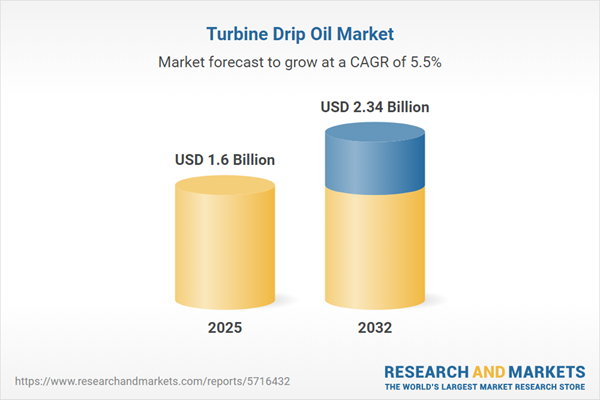Speak directly to the analyst to clarify any post sales queries you may have.
Senior executives navigating procurement and operational strategy in the turbine drip oil market face an increasingly complex landscape shaped by evolving regulations, sustainability imperatives, and technological advancements. Informed insights are essential for aligning sourcing and compliance priorities amidst global transformation.
Market Snapshot: Turbine Drip Oil Market Growth
In 2024, the turbine drip oil market remains an essential segment within power generation and industrial domains, underpinning critical lubrication needs and enhancing equipment protection. Market analysis places its current value at USD 1.52 billion, with projected expansion to USD 1.60 billion by 2025 and an anticipated value of USD 2.34 billion by 2032. This steady growth reflects a 5.54% compound annual rate, fueling heightened attention on maintenance strategies and alignment of operations with sustainability and regulatory frameworks. Executives across industry sectors are increasingly adopting data-driven frameworks to optimize cost management, extend system lifecycles, and drive asset performance with sustainability in mind.
Scope & Segmentation: Strategic Market Overview
This report equips senior leaders and teams with targeted analysis to facilitate adaptive procurement and value-driven operations. The segmentation below addresses both tactical and strategic considerations shaping purchasing and operational outcomes:
- Type: Covers mineral-based, semi-synthetic, and synthetic turbine oils, providing clarity on their performance in supporting outstanding maintenance cycles, operational longevity, and compliance sustainability.
- Application: Addresses lubrication requirements for gas, hydroelectric, steam, and wind turbine systems, emphasizing the vital role of adaptability in diverse conditions and monitoring how technological improvements are influencing oil reliability.
- End User Industry: Explores key participant sectors including chemical processing, manufacturing, oil and gas, and utility providers, illuminating procurement challenges, integration methodology, and the benchmarks for evaluating supply partners.
- Distribution Channel: Distinguishes between OEM and aftermarket supply chain models, offering perspective on maintenance logistics, part replacement cycles, and management of supplier networks for enhanced reliability.
- Regional Coverage: Investigates geographic market drivers and procurement behaviors across the Americas, Europe, the Middle East and Africa, and Asia-Pacific, with a focus on regulatory compliance, capital investments, and evolving supply chain dynamics.
- Key Companies: Highlights prominent industry entities—including Exxon Mobil, Shell, BP, TotalEnergies, Chevron, China Petroleum & Chemical Corporation, PetroChina, Fuchs Petrolub, Idemitsu Kosan, and Petroliam Nasional Berhad—profiling innovation capabilities, collaborative partnerships, and their influence on turbine oil sector advancements.
Key Takeaways: Strategic Insights for Decision-Makers
- Innovation in lubricant chemistry and formulation is enhancing reliability and reducing the frequency of unplanned maintenance cycles, allowing for consistent operational schedules.
- Heightened environmental focus is encouraging the integration of bio-based and environmentally preferable drip oil alternatives across production and distribution layers.
- Digitalization, including predictive maintenance platforms and asset monitoring tools, is allowing operators to move from reactive to proactive maintenance planning, resulting in more effective lifecycle management.
- Procurement protocols are evolving to prioritize a broader supplier base, reducing dependency risks and improving business continuity in changing supply chains.
- Regional differences in technology adoption and regulatory frameworks are leading to distinct operational dynamics worldwide, as certain areas champion digital integration and others emphasize adherence to strict environmental standards.
- Stronger collaboration between oil producers, additive suppliers, and equipment manufacturers is enabling tailored lubricant solutions and faster adaptation to operational demands.
Tariff Impact: U.S. Trade Policy and Market Response
Forthcoming U.S. tariff adjustments in 2025 are prompting companies to reevaluate sourcing frameworks and risk mitigation strategies. Organizations are responding by deepening local procurement models, fortifying contractual certainty, and intensifying supplier engagement to minimize exposure to fluctuating costs associated with policy revisions.
Methodology & Data Sources
This report's findings derive from extensive executive interviews, in-depth technical reviews, regulatory assessments, patent trend evaluations, and analysis of global trade data. Integrating varied data perspectives supports objective evaluation and sound strategy formulation for executive agendas.
Why This Report Matters
- Assists senior leaders in shaping and executing strategies that reflect current trends, regulatory requirements, and evolving market behaviors across regions.
- Provides a clear benchmarking framework for efficiency, vendor selection, and assessment of supply network resilience in varied operational environments.
- Enables organizations to anticipate and mitigate regulatory or trade-related disruptions through scenario-driven planning and real-time data intelligence.
Conclusion
This analysis equips decision-makers to proactively respond to market developments, uphold compliance, and nurture strong supplier partnerships, ensuring resilient operations in the turbine drip oil sector.
Additional Product Information:
- Purchase of this report includes 1 year online access with quarterly updates.
- This report can be updated on request. Please contact our Customer Experience team using the Ask a Question widget on our website.
Table of Contents
3. Executive Summary
4. Market Overview
7. Cumulative Impact of Artificial Intelligence 2025
Companies Mentioned
The companies profiled in this Turbine Drip Oil market report include:- Exxon Mobil Corporation
- Shell PLC
- BP PLC
- TotalEnergies SE
- Chevron Corporation
- China Petroleum & Chemical Corporation
- PetroChina Company Limited
- Fuchs Petrolub SE
- Idemitsu Kosan Co., Ltd.
- Petroliam Nasional Berhad
Table Information
| Report Attribute | Details |
|---|---|
| No. of Pages | 194 |
| Published | November 2025 |
| Forecast Period | 2025 - 2032 |
| Estimated Market Value ( USD | $ 1.6 Billion |
| Forecasted Market Value ( USD | $ 2.34 Billion |
| Compound Annual Growth Rate | 5.5% |
| Regions Covered | Global |
| No. of Companies Mentioned | 11 |









